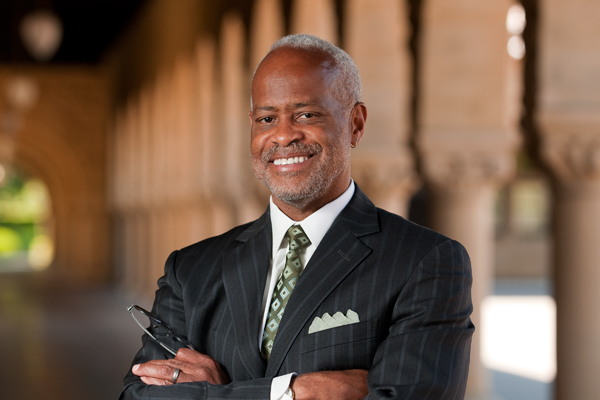
2010: The Year in Review
Among the significant events that occurred at Stanford during the 2010 year are the following:
January
Peter Vitousek, the Clifford G. Morrison Professor in Population and Resource Studies, wins the 2010 Japan Prize for pioneering work in biogeochemistry.
Stanford senior leadership matches donations made by faculty and staff to the Hôpital Albert Schweitzer in Haiti, which withstood the massive Jan. 12 earthquake.
President John Hennessy, co-chairman of the Committee on Science, Security and Prosperity of the National Research Council, testifies before an on-campus open hearing of the House Foreign Affairs Committee, urging lawmakers to rewrite export controls to reflect the modern realities of worldwide scientific collaboration and competition.
At a congressional hearing held on the Stanford campus, President John Hennessy told representatives that the country risks losing its competitive edge unless Cold War-era export control laws are revamped.
Applications for the fall freshman class increase 5.6 percent and set a record at 32,000.
Richard Zare, the Marguerite Blake Wilbur Professor in Natural Science, attends a White House celebration to receive a Presidential Award for Excellence in Science, Mathematics and Engineering Mentoring.
David Donoho, the Anne T. and Robert M. Bass Professor in the School of Humanities and Sciences, wins the Norbert Wiener Prize in Applied Mathematics, given every three years, for “introducing novel fundamental and powerful mathematical tools in signal processing and image analysis.”
The Law School launches a private venture in legal informatics called Lex Machina—the outgrowth of a research project called the Stanford Intellectual Property Litigation Clearinghouse.
February
A Secure Data Center opens on campus to give faculty and student researchers access to information accumulated by the Census Bureau, the National Center for Health Statistics and other federal agencies.
Former Stanford Daily editor Devin Banerjee receives the 2010 Daniel Pearl Memorial Journalism Internship at the Wall Street Journal. The internship honors the Stanford alumnus slain in Pakistan in 2002.
Stanford Professor Martin Hellman helped make it possible for companies and ordinary people to encrypt their Internet communications, and he has a story to tell about it.
Martin Hellman, professor emeritus of electrical engineering, receives the 2010 Richard W. Hamming Medal of the Institute of Electrical and Electronics Engineers for development of the public key cryptography that makes Internet commerce feasible.
After years of design, assembly and testing, a space camera developed by researchers from Stanford and Lockheed Martin blasts into space to reveal the sun’s inner workings.
David A. B. Miller, the W. M. Keck Foundation Professor of Electrical Engineering, and Hau Lee, the Thoma Professor of Operations, Information and Technology at the Graduate School of Business, are elected to the National Academy of Engineering.
The National Science Foundation awards $10 million to the Institute for Research in the Social Sciences to fund the American National Election Studies, under the auspices of political science Professors Simon Jackman and Gary Segura.
March
Energy Secretary and Nobel laureate Steven Chu, professor emeritus of physics, returns to campus to speak at Memorial Auditorium about sustainable energy and its importance to economic competitiveness in the United Sates.
The John A. and Cynthia Fry Gunn Building, which is the new home of the Stanford Institute for Economic Policy Research, was dedicated on March 11, 2010.
The John A. and Cynthia Fry Gunn Building is dedicated during the annual Economic Summit of the Stanford Institute for Economic Policy Research.
Three Medical School students and three undergraduate alumni receive Paul & Daisy Soros Fellowships for New Americans: AbdulRasheed Alabi, Shah Ali, Tarek Ghani, Bowen Jiang, Tony Pan and Philip Tanedo.
Thomas Kailath, the Hitachi America Professor in the School of Engineering, Emeritus, wins the BBVA Foundation Frontiers of Knowledge Award in Information and Communication Technologies for work that enabled chip miniaturization and led to the development of a new antenna system used in the now ubiquitous Wi-Fi technology.
Arthur Bienenstock, professor emeritus of photon science and special assistant to the president for federal research policy, is elected to the Royal Swedish Academy of Engineering Sciences.
April
Bill Gates, co-chair of the Bill & Melinda Gates Foundation, talks in Memorial Auditorium to students as the Freeman Spogli Institute Payne Lecturer about the need to improve health care, bolster education and fight poverty around the world.
Philanthropist Bill Gates visited Stanford on April 19, 2010, to promote the work of his foundation and to inspire students.
The Pritzker family of Chicago pledges $10 million to create a scholarship fund to help Chicago-area students with need attend the university.
Junior Varun Sivaram receives a Truman Scholarship, which provides up to $30,000 for graduate study to college students committed to careers in public service.
German Chancellor Angela Merkel speaks about international cooperation and tells a capacity crowd that “freedom and solidarity and partnership belong together. They must be indivisible for us to be able to master the challenges ahead.”
German Chancellor Angela Merkel visited Stanford and spoke to an audience of students, faculty and staff about the war in Afghanistan, international cooperation and global warming. She toured Stanford's Volkswagen Automotive Innovation Lab and dedicated the new building that houses the facility.
The Hasso Plattner Institute of Design settles into its new home in the renovated Peterson Building.
Persis Drell, director of the SLAC National Accelerator Laboratory and professor of particle physics and astrophysics; Jerome Friedman, professor emeritus of statistics; Steven Kivelson, professor of physics; Roeland Nusse, professor and chair of developmental biology; and Lee Ross, the Stanford Federal Credit Union Professor in the Department of Psychology, are elected to the National Academy of Sciences.
May
Paul Volcker, former Federal Reserve chair, receives the first $100,000 Stanford Institute for Economic Policy Research Prize for Contributions to Economic Policy.
Stanford faculty and staff are among 229 scholars elected to the American Academy of Arts and Sciences:
- Christopher Field, professor of biology and of environmental Earth system science
- Michael Keller, the Ida M. Green University Librarian
- Karla Kirkegaard, professor of microbiology and immunology
- Michael Levitt, professor of structural biology
- Grigori Mints, professor of philosophy
- Parviz Moin, the Franklin P. and Caroline M. Johnson Professor in the School of Engineering
- Myron Scholes, the Frank E. Buck Professor of Finance, Emeritus
- Gary Segura, professor of political science
- Thomas Südhof, the Avram Goldstein Professor in the School of Medicine
- Philip Zimbardo, professor emeritus of psychology
Peter and Helen Bing join President Hennessy for the ceremonial groundbreaking for the new Bing Concert Hall.
Pam Grossman, the Nomellini-Olivier Professor of Education, is elected to the National Academy of Education.
June
Thomas Südhof, the Avram Goldstein Professor in the School of Medicine, is named a recipient of the 2010 Kavli Prize, given for achievements in neuroscience, nanoscience and astrophysics.
Drawing on an experience in war-torn Angola, U.S. Ambassador to the United Nations Susan Rice urged Stanford's Class of 2010 to use their skills and smarts to bridge the gaps of global disparities.
The School of Medicine will develop a new Center for Cancer Systems Biology, thanks to a $12.8 million grant from the National Cancer Institute.
Susan Rice, U.S. ambassador to the United Nations, tells graduates at Commencement that the fight against global poverty is “not only one of the great moral challenges of all time, but also one of the great national security challenges of our time.”
Harry Elam, the Olive H. Palmer Professor in Humanities, is appointed the Freeman-Thornton Vice Provost for Undergraduate Education, succeeding John Bravman, who was appointed president of Bucknell.
Russian President Dmitry Medvedev comes to Stanford to learn more about the success of Silicon Valley and speaks about efforts to wean the Russian economy from a dependence on oil and increase investments in technology.
Stanford Athletics wins its 16th consecutive Learfield Sports Directors’ Cup, which recognizes the top intercollegiate athletic program in the nation.
Two dozen Stanford students and alumni are selected for fellowships funded by the Fulbright U.S. Student Program.
The Stanford Board of Trustees approves a new proxy voting guideline that says the university will vote “yes” on shareholder resolutions that ask companies to report on their policies on conflict minerals and conflict mineral derivatives.
Four new members are elected to the Board of Trustees: Armando Garza Sada, Frank Don Lee, Paul Alan Ormond and Deborah Anne Zoullas.
July
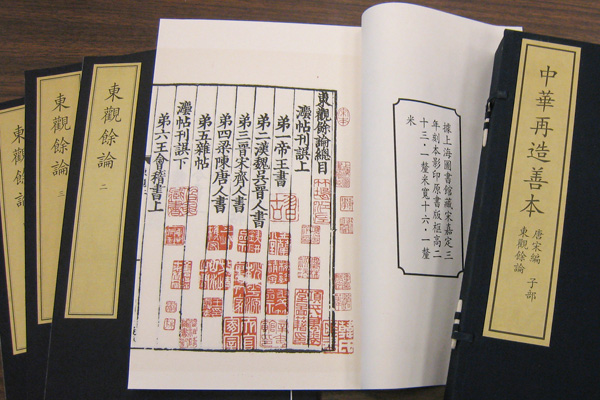
Books from a newly donated collection represent the four traditional realms of Chinese knowledge: history, philosophy, literature and classics. (Qi Qiu)
The Stanford University Libraries acquires a 9,100-volume collection of reproductions of ancient Chinese books that chronicle the civilization’s past.
Philanthropist, diplomat, publisher and Stanford alumnus Bill Lane dies at 90.
President Obama appoints Mariano-Florentino Cuellar, professor of law, to the Council of the Administrative Conference of the United States.
August
Leslie Hume, chair of the Board of Trustees, signs a lease with the U.S. Department of Energy allowing the SLAC National Accelerator Laboratory to continue to operate on university-owned land for the next 33 years.
U.S. Secretary of Energy Steven Chu joins SLAC National Accelerator Laboratory Director Persis Drell, President John Hennessy and other dignitaries for the dedication of the Linac Coherent Light Source, the world’s most powerful X-ray laser.
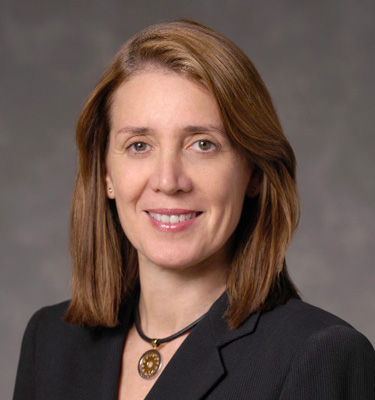
Ruth Porat
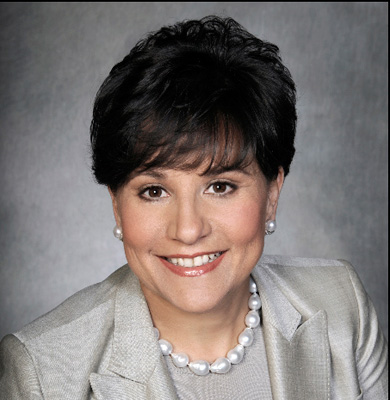
Penny Pritzker
Ruth Porat, executive vice president and chief financial officer of Morgan Stanley, and Penny Pritzker, chair of TransUnion and the Pritzker Realty Group, are elected to the Board of Trustees.
The new Center for Nanoscale Science and Engineering opens in the Science and Engineering Quadrangle.
September
The Volvo Environment Foundation awards its annual prize to Harold Mooney, the Paul S. Achilles Professor of Environmental Biology.
Gretchen Daily, the Bing Professor in Environmental Science and senior fellow at the Woods Institute for the Environment, is named a recipient of the 2010 Heinz Awards for her work to place a value on the services provided by natural ecosystems.
The Stanford Cancer Center treats the 5,000th patient using the CyberKnife, invented by John Adler, the Dorothy and Thye King Chan Professor in Neurosurgery, to combine computer imaging and robotic motion to treat the most difficult cancers.
Carlos Bustamante, professor of genetics, is named a MacArthur Foundation fellow; the award is commonly known as the “genius grant.”
The School of Medicine’s Li Ka Shing Center for Learning and Knowledge is dedicated.
The Stanford Encyclopedia of Philosophy, which attracts 700,000 visits per week on the Internet, celebrates its 15th anniversary.
The Stanford Human Immune Monitoring Research Center is created by a $17.1 million grant from the National Institutes of Health under the directorship of Mark Davis, the Burt and Marion Avery Family Professor, to characterize the human immune system under normal conditions and to learn how it changes following infection and vaccination.
October
The Jen-Hsun Huang Engineering Center, the new home for the School of Engineering, is dedicated.
The Dalai Lama visits campus to deliver several talks and to attend a conference on compassion sponsored by the Medical School’s Center for Compassion and Altruism Research and Education.
Board of Trustees members fete President John Hennessy and Provost John Etchemendy for their 10 years in office, noting that Etchemendy is now the longest serving provost in Stanford history.
Stanford celebrates the dedication of the Lorry I. Lokey Stem Cell Research Building at the School of Medicine—the largest such research facility in the nation.
Google announces it will test its ultra-high-speed broadband network within the university’s faculty/staff housing subdivision, beginning in 2011.
November
Actor George Clooney and activist John Prendergast talk to a capacity crowd in Cubberley Auditorium about the volatility threatening to spark more genocide in Sudan.
Four faculty are recognized with Presidential Early Career Awards for Scientists and Engineers: Dominique Bergmann, assistant professor of biology; Gianluca Iaccarino, assistant professor of mechanical engineering; Jacob Wacker, theoretical physicist at SLAC; and Joseph Wu, associate professor of medicine and radiology.
Seniors Fatima Sabar and Varun Sivaram and alumnus Fagan Harris are among 32 Americans awarded Rhodes Scholarships for 2011, while alumnus David Gobaud won a George J. Mitchell Scholarship.
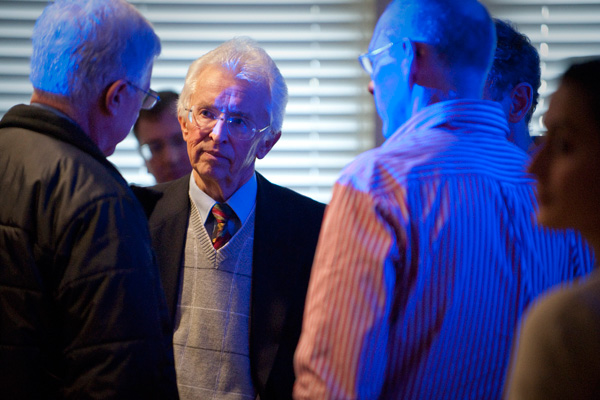
Siegfried Hecker, co-director of the Center for International Security and Cooperation, stunned the world in November with news of North Korea's uranium enrichment facility. (L.A. Cicero)
Siegfried Hecker, co-director of the Center for International Security and Cooperation at the Freeman Spogli Institute (FSI); Robert Carlin, FSI visiting scholar; and John Lewis, William Haas Professor of Chinese Politics, Emeritus, stunned the world with news of North Korea’s new uranium-enrichment facility.
A gift from alumni couple Thomas Steyer and Kat Taylor funds the Steyer-Taylor Center for Energy Policy and Finance and allows the business and law schools to push clean energy technology to deployment.
December
The Cardinal football teams ends the season with 11 wins for the first time in school history and earns an invitation to the Discover Orange Bowl, while quarterback Andrew Luck finishes as the Heisman Trophy runner up.


